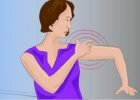

Sciatica is described as pain which starts in the lower back and goes down the leg. The pain ranges through the whole lower body because the sciatic nerve is the longest and widest nerve in the human body. Usually, the sciatica symptoms appear only on one side of the body, but in some cases, pain may be felt on both sides.
The sciatica symptoms include lower back pain, pain in the leg that is worse when sitting, weakness, numbness, or difficulty moving the leg or foot, a constant pain on one side of the rear, and severe pain which makes it difficult to stand up. The most common cause of sciatica is a herniated disc that presses on the sciatic nerve. Other causes include lumbar spinal stenosis (commonly described as narrowing of the spinal canal in the lower back), pregnancy, tumors on the spinal cord, and trauma to the spine. Sometimes, however, there is another cause of sciatica which goes unnoticed by most health professionals.
The Hidden Cause for Sciatica!
The piriformis muscle is a muscle in the gluteal region of the lower limb. It is one of the six muscles in the lateral rotator group. Because it’s woven through bone and other muscles, it can be missed when diagnosing sciatica. Piriformis syndrome is a neuromuscular disorder that occurs when the sciatic nerve is compressed by the piriformis muscle. It causes pain, tingling, and numbness in the buttock, posterior thigh, and the lower leg. If the cause of sciatica is the piriformis muscle, it can be treated without surgery, physical therapy, or pharmaceuticals.
How to Treat Sciatica?
We must move every muscle, and the piriformis is not an exception. Stretching is one of the best ways to relieve constriction and tension in the muscles, thus reducing inflammation and nerve pain as a result. We will present you two exercises that target the piriformis.
- Lie on your back with your legs flat. Pull the affected leg up toward the chest, holding your left knee with your left hand and grasping the ankle with the other hand. Pull the knee towards your opposite leg until you feel a light stretch (do not force the ankle or knee beyond the stretch). Stay in this position for 30 seconds, then return to the starting position. Repeat the exercise three times.



- Lie on the floor with the affected leg crossed over the other leg at the knees and both legs bent. Gently pull the lower knee up toward the shoulder on the same side of the body until you feel the stretch. Stay in this position for 30 seconds, then return to starting position. Repeat the exercise three times.

Non-invasive Treatments!
- Devil’s claw is a genus of plants in the sesame family, native to southern Africa. The roots and tubers of the plant contain powerful anti-inflammatory properties and can be used in the treatment arthritis, headache, and lower back pain. You can find devil’s claw in natural food stores in the form of capsules or powder. People who suffer from peptic ulcers or take blood-thinning medications should avoid this herb.
- Hot and cold therapy can help reduce inflammation and relieve pain. Hold an ice pack on the affected area for 10 minutes, then replace it with an electric heating pad for 10 minutes, and after that hold an ice pack again. This will improve blood flow in the painful area and relax tight muscles.
- St. John’s wort is a medicinal herb known for its antidepressant abilities and powerful anti-inflammatory properties. It can be found in most grocery and health food stores. You can relieve pain by massaging the affected area with St. John’s wort oil.
We recommend you to combine all the treatments mentioned above in order to get the best possible results.


-
Rick Hill




